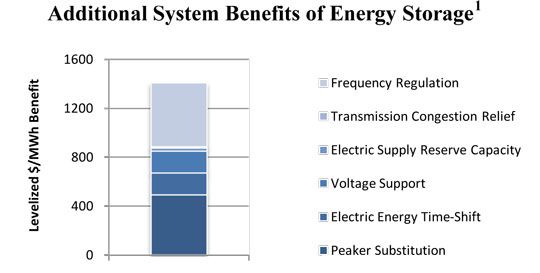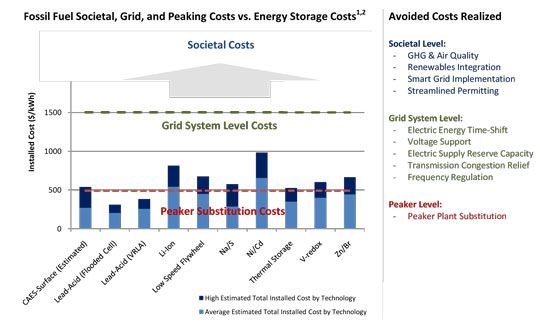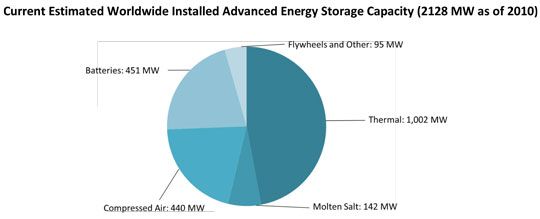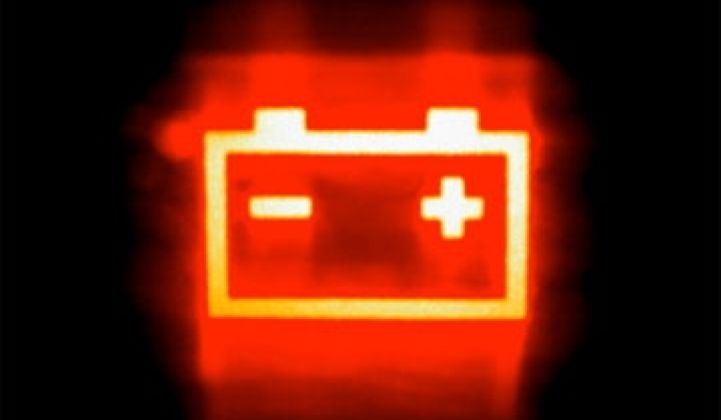Energy storage systems store energy for use at a later time, when electric power is most needed and most valuable, such as on hot summer afternoons. Energy storage helps integrate intermittent renewable sources, can supplant the most polluting power plants, and enhances grid reliability. There are many ways to store energy, including chemically (batteries), mechanically (flywheels) and thermally (ice).
Due to insufficient energy storage for the electric power grid, utilities must size their generation and transmission systems to deliver the full amount of electricity that consumers demand (or might demand) at any given moment of the year. Owning and operating sufficient assets to serve peak demand -- only 5% or less of the hours per year -- results in increased emissions and costs to electricity customers.
Energy storage has the unique potential to transform the electric utility industry by improving existing asset utilization, avoiding the building of new power plants, and avoiding or deferring upgrades to existing transmission and distribution networks. Scientists, utility CEOs, and policymakers frequently refer to energy storage as the "Holy Grail" for the electric power industry. The California State Senate will soon hold hearings on AB 2514, an assembly bill to to promote energy storage in the state. A complete white paper on the topic from Strategen can be found here.
More recently, energy storage has achieved recognition as a foundational element of the smart grid, and the technical community speaks of energy storage as a key enabling resource to facilitate the transition away from a fossil-fuel-dominated generation fleet to one that is cleaner, more reliant on renewables, "smarter," and able to accelerate the electrification of the transportation sector. The following analysis demonstrates the value of energy storage as an alternative to natural gas-fired peaker plants.
Energy Storage Technologies Can Now Deliver On-Peak Electricity at a Lower Cost than Gas-Fired Peakers
To help illustrate the cost effectiveness of energy storage, we compared the cost of a kilowatt-hour (kWh) of electricity generated on-peak by a gas-fired peaker with the cost of a kWh of electricity provided on-peak by an energy storage system. For simplicity, this comparison used a commercially available energy storage technology -- lead-acid batteries -- and used the cost and specifications similar to the large lead-acid energy storage peaking facility shown below. Located in Chino, California, this 10-megawatt (MW), 4-hour-duration system successfully demonstrated energy storage's ability to manage peak load from 1988 through 1996.[1]
Using assumptions taken from a recent California Energy Commission (CEC) study, our analysis found a levelized cost of generation for the simple cycle gas-fired peaker plant of $492 per megawatt-hour (MWh), or $203 per kilowatt-year (kW-yr). In comparison, the energy storage plant demonstrated significant savings, with a levelized cost of generation of $377 per MWh ($155/kw-yr). A detailed version of this analysis, including all assumptions, is available in the full white paper.

Energy Storage Has the Ability to Deliver More than Peaker Substitution Value to the Grid
Energy storage provides multiple value streams above and beyond peaker substitution. For example, by their nature, gas-fired peaker plants cannot be economically sized below 50 MW and therefore are not easily installed in a distributed footprint. Energy storage systems do not have this limitation, opening up the potential for many technical and economical benefits available to distributed energy resources, such as reduction of transmission and distribution losses. Additional benefits include electric energy time-shift, voltage support, electric supply reserve capacity, transmission congestion relief, and frequency regulation. Ranges for each of these value streams have recently been quantified by Sandia National Laboratories, and are presented in the chart below.

Energy Storage is the Most Cost-Effective Resource
When these benefits are factored in and compared to the total installed cost for a range of energy storage technologies, energy storage emerges as a comprehensive, cost-effective system resource.

The bars in the chart above represent the total installed cost per kWh of energy storage capacity by major storage technology, assuming four hours of capacity for each. The red dashed line indicates where storage costs are at cost parity with a natural gas-fired peaker. The green dashed line indicates the grid system level costs that are avoided with energy storage -- in other words, this line is representative of other real system costs that are borne by electricity customers. Finally, the blue arrow represents the total societal cost avoided by energy storage, including its ability to help achieve a smart grid, accelerate and facilitate renewables integration, and avoid GHG emissions.
Energy Storage is a Cleaner Alternative to Natural Gas-Fired Peakers
Grid storage displaces less efficient, dirtier peaker generation by time-shifting more efficient, cleaner base-load generation to peak periods. This results in substantial system-wide air quality benefits. For example, assuming Pacific Gas and Electric's base load electric mix as the off-peak source of electricity, energy storage would provide 55% CO2 savings, 85% NOx savings, and up to 96% savings of CO per MWh of on-peak electricity delivered. These emissions benefits increase as more off-peak renewable generation comes on-line. Energy storage will also help optimize the use of existing transmission and distribution capacity, enabling the deployment of more renewable energy. Finally, because of its ability to store locally generated power and be remotely dispatched, energy storage is an indispensable component of a more affordable, secure and reliable smart grid.
Smart, Clean, Cost-Effective Energy Storage: Ready for Deployment
Modern energy storage technologies, some of which have been in existence for decades, cover a wide range of sizes, power (measured in MW), and discharge durations (measured in hours). An energy storage system can be either centralized or distributed and can be utility-owned, customer-owned or third-party owned. Today, there are more than 2,000 MW of installed grid-connected energy storage technologies deployed worldwide, with a comparable amount under development.[5]
Current Estimated Worldwide Installed Advanced Energy Storage Capacity

Why Isn't Energy Storage Being Widely Used in California?
Current California policy has not kept pace with advances in energy storage technology, yet energy storage can cost-effectively help address California's many energy policy challenges, such as greenhouse gas emissions reduction, renewables integration, transmission and distribution constraints, increasing peak demand and enabling electric vehicles.
Energy storage technologies are well established in other industries and market applications. Grid storage, a key component of the electric power industry, represents a large new market application for both existing and emerging energy storage technologies. Unfortunately, the electric power industry is a highly regulated industry that has historically overlooked using storage for grid optimization. As a result, current market structure does not allow for the buyer of the storage equipment to easily capture all the value streams provided by storage across the entire electric power system.
The chief barrier here is neither the availability of a reliable energy storage technology nor its cost; the barrier is the current accounting of disaggregated benefits in a deregulated utility industry and lack of clear policy direction to utilities that energy storage is a superior alternative to gas-fired peakers. Thus, while energy storage presents compelling social and economic benefits, California's current market structure has led to underinvestment.
Key State and Federal Policy Recommendations to Realize the Benefits of Energy Storage
State Recommendations
1) Require utilities to evaluate procurement targets for cost-effective storage deployment (e.g., AB 2514)
2) Encourage diversity in energy storage technology deployment, including market application and ownership options to foster utility-, third-party-, and customer-owned applications
3) Fully implement SB 412 to provide Self Generation Incentive Program (SGIP) incentives for energy storage coupled with solar and used in a stand-alone manner on the customer side of the meter
4) Implement energy-storage focused rulemaking, require consideration of energy storage as a valued system resource in all regulatory proceedings (e.g., distributed generation, smart grid, renewables, and demand response/permanent load shifting)
5) Include energy storage in a standardized cost-effectiveness methodology applicable to all resources
6) Require utilities to include energy storage as a bidding option in peaking capacity Requests for Offers (RFOs)
7) Require storage as part of long-term procurement process, including pursuing standard offers for permanent load shifting
8) Explore tariff design that encourages load shifting
9) Increase feed-in tariff price for renewables firmed/shifted with energy storage
10) Accelerate the CAISO's stakeholder processes to achieve comparability of energy storage (implementation of FERC Orders 890 and 719)
11) Consider peak reduction standard for state agency power purchases
12) Clarify net metering rules for renewable energy projects with storage
Federal Recommendations
1) Support extension of the existing federal investment tax credit to energy storage systems (e.g., S.1091)
2) Add energy storage as its own category in the FERC's Uniform System of Accounts
[1] EPRI Chino Study TR-101787, Chino Battery Energy Storage Power Plant: Engineer-of-Record Report (December 1992)
[2] Source: SANDIA Report SAND2010-0815, Energy Storage for the Electricity Grid: Benefits and Market Potential Assessment Guide, Jim Eyer & Garth Corey (February 2010)
[3] Assumptions: All energy storage technology costs shown are normalized for a four-hour duration; Technology comparison is for modern energy storage systems only, but does not include pumped hydro or high-speed flywheels which are not designed for long-duration peaking applications
[4] Source: Average estimated total installed cost estimate from: Sandia Report SAND2008-0978, Susan M. Schoenung and Jim Eyer, Benefit/Cost Framework for Evaluating (February 2008)
[5] Source: StrateGen and CESA research. Excludes pumped hydro capacity, estimated at ~123 GW
***
Authors: Janice Lin and Giovanni Damato, StrateGen Consulting LLC



